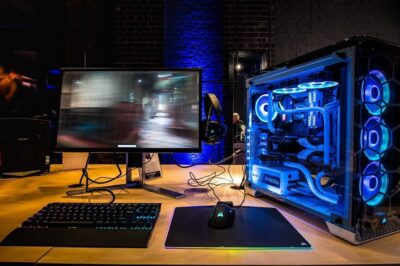7 Components of Gaming Monitors You Must Check Before Buying
Displays such as 240Hz monitors are built specifically to make your computer’s graphics card and processor output appear their best in-game. Monitors provide the ultimate output of your computer’s picture rendering and processing, but they display colors, motion, and sharpness differently. It’s important to know what features to seek in a gaming monitor and how to convert technical specifications into actual gaming performance.
240-Hz gaming monitors are the most advanced devices that provide immaculate visuals. When you play games or perform resource-intensive tasks, you require a monitor screen with a higher refresh rate so that you can see everything easily. That’s why if you are investing in a gaming screen, you must research its elements properly. Read this article to learn about the 7 most prominent components of gaming pc and monitors that you must check before buying.
Screen Size
Bigger screens provide better contrast, resolution, and brightness. Your eyes feel less strain as a result of a wider screen since bigger screens can have a more natural viewing angle for your eyes. Widescreen computer monitors make it easy to do side-by-side activities that would be difficult on a conventional screen because the information is shown closer to the center of your vision, eliminating the need to squint. Look at two files at once, play media in many windows, and arrange your workspace to be as efficient as possible.
Resolution
Among the most important aspects of a display is its resolution. Popular resolutions include 1,920 by 1,080 pixels (also known as “Full HD” or “Full 1080p”), 2,560 by 1,440 pixels (also known as “Quad HD” or “Widescreen Quad HD”), and 3840 by 2160 pixels (“Ultra HD” or “4K Ultra HD”). More pixels mean greater detail, which produces a more satisfying viewing experience. High-definition displays provide better graphics for creative asset creation and technical image analysis.
Refresh Rate
The pace at which your full screen refreshes the picture is known as the refresh rate. A higher refresh rate allows for a more fluid appearance of motion onscreen by more often updating the location of each item. For gaming, the suggested minimum refresh rate is 60 Hz. Realistically, faster refresh rates aid gamers by ensuring that what they see on screen corresponds to what is occurring on the computer. Although 60 Hz used to be the standard, several screens can now run at 240 Hz. For serious gaming, this is a must-have since there is a noticeable difference between 240 Hz gaming monitors and 60 Hz ones.
Response Time
The term response time describes how long it takes for a single pixel to switch between states. In most cases, this is expressed as the number of milliseconds (ms) between two successive grayscale transitions (GtG). Sub-5 ms is the minimum acceptable latency for gaming, with 2 ms and 1 ms being much better. While playing a fast-paced game, a sluggish reaction time might generate noticeable motion blur or ghosting since the display isn’t up to speed. Maintaining a clear and detailed picture requires a high refresh rate and a quick reaction time.
Adaptive Sync to Prevent Screen Tearing
The screen tearing occurs when the monitor simultaneously shows a portion of one frame and the next frame. The picture seems divided when the sync is disrupted, so you’ll notice it. This occurs because displays are programmed to operate at a certain refresh rate and do not always know what to do when the frame data they receive does not match their hardwired settings. VSync is a simple choice since it instructs the display to wait for the complete next frame before switching.
HDR
HDR eliminates the restrictions of previous video signals and gives data on hue and saturation in a much broader range. If the display is HDR-capable, it will read the data and reconstruct the picture using a greater range of tones and intensities. High dynamic range will have a greater impact on picture quality than an increase in resolution. You must ensure that your operating system, graphics card, and display all support HDR for it to function.
Additional HDR Info
High Dynamic Range displays provide more contrast with brighter highlights and deeper shadows while preserving the same level of information. In addition, they support more vibrant hues.
HDR needs a suitable image pipeline comprising an operating system, graphics card, display, and game to perform effectively.
Having a display that conforms to the DisplayHDR standard is also advantageous.
Ports
Behind or below your screen are a plethora of ports. The monitor’s display interface communicates with the computer’s graphics output, while other connections, such as USB and ThunderboltTM, provide data and power to peripherals. To free up USB ports on your computer, you can link your keyboard and mouse to several displays. Active cables (cables that incorporate an electrical circuit) are required for full bandwidth in DisplayPort 2.0; however, all previous versions of DisplayPort use the same cables. Checking the number of available ports on display is also dependent on the capabilities of your personal computer.
Conclusion
The gaming experience is enhanced by 240Hz monitors because they have a fast refresh rate and a short reaction time. These devices also have more stable images on a gaming display, which is the result of anti-tearing technology, while greater color reproduction benefits not just games but all media. The components mentioned above are the significant elements that you must check before purchasing a gaming screen.
